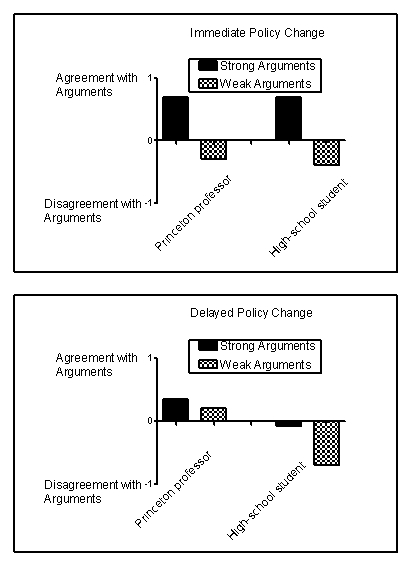Scenario II
The following scenario contains fabricated results consistent with the following study:
Petty, R. E., Cacioppo, J. T., & Goldman, R. (1981) . Personal involvement as a determinant of argument-based persuasion. Journal of Personality and Social Psychology, 41, 847-855.
Every day, consumers are exposed to scientifically based sales, marketing, and public relations strategies designed to influence purchasing decisions, change opinions, or win votes. One common sales strategy is the foot-in-the-door technique, a method that involves first making a smaller request that consumers are likely to grant and then following it by a larger request. Another common strategy is the door-in-the-face technique, which involves making an unreasonably large request that consumers will reject and then following it by a smaller request. When persuasion is necessary, it usually takes one of two forms: heuristic persuasion involves an appeal to habits or emotion, and systematic persuasion involves an appeal to facts and reason. Often, people will rely more on heuristics-simple short-cuts or "rules of thumb"-to make decisions instead of systematically weighing the evidence.
Petty and colleagues (1981) investigated some of these techniques in college students listening to arguments in favor of their college requiring an institution-level comprehensive final examination for graduation. Some students were led to believe that, if adopted, this policy would take place right away, and some were led to believe that the change would take place in a decade. In addition, some of the students were led to believe that they were listening to an argument from a Princeton professor, and others were led to believe that they were listening to an argument from a high-school student. Finally, some students heard strong arguments in favor of the policy, and some heard weak arguments. Thus, the experiment arranged six groups of students. For example, one group of students heard strong arguments from a high-school student about a far-removed policy change. Figure 13.1 shows fabricated results illustrating the major findings of this experiment.
Figure 13.1 
-(Scenario II) Which is an example of systematic persuasion?
Definitions:
Capillaries
The smallest blood vessels in the body, connecting arteries to veins, which facilitate the exchange of water, oxygen, carbon dioxide, and many other nutrient and waste substances between blood and surrounding tissues.
Arteries
Blood vessels that carry oxygen-rich blood away from the heart to the body.
Echocardiography
Echocardiography is a diagnostic procedure that uses ultrasound waves to create images of the heart, allowing for the assessment of its structure and function.
Electrocardiogram
A test that measures the electrical activity of the heart to show whether it is working normally or to detect heart conditions.
Q2: There is a negative correlation between testosterone
Q3: (Scenario II) The door-in-the-face technique works primarily
Q10: Which of these 50-year-old men is MOST
Q26: Positive as well as negative events are
Q32: As relationships grow older, people are more
Q37: The concordance rate for schizophrenia among identical
Q83: In answer to stress, the body responds
Q84: A government that imposes harsh penalties for
Q107: Which statement is NOT a reason many
Q121: _ appraisal refers to the process by